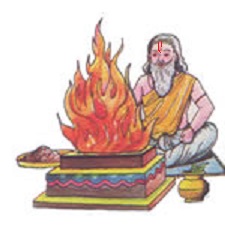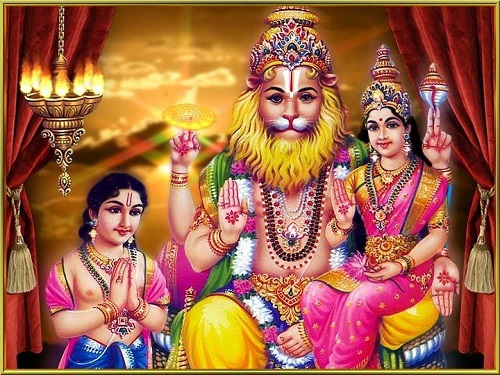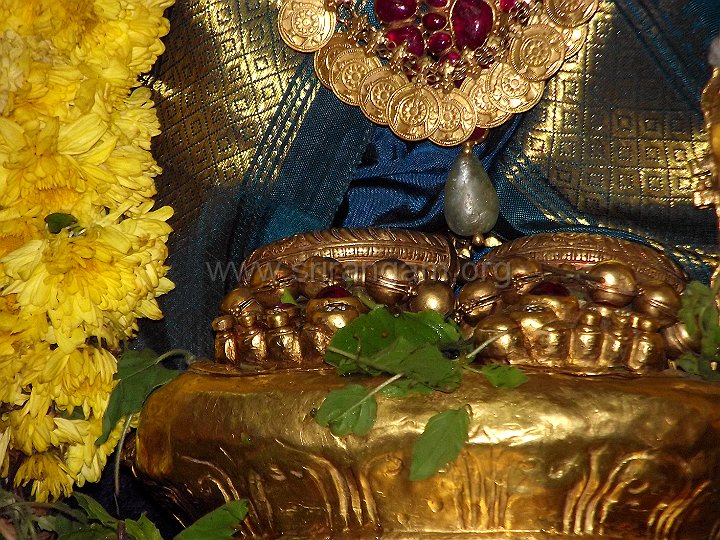srI:
srImathE satakOpAya nama:
srImathE rAmAnujAya nama:
srImath varavaramunayE nama:
karma, gyAna, bhakthi yOgams explained
SlOkam 23
karmayOgasthapasthIrthadhAnayagyAdhisEvanam |
gyAnayOgOjithasvAnthai:parisudhdhAthmani sthithi: ||
 |
 |
Listen
Word-by-word meaning
karma yOga: – karma yOgam is
thapas thIrtha dhAna yagyAdhi sEvanam – engaging continuously in thapasya (penance), thIrtha yAthrai (pilgrimage), dhAnam (charity), yagyam (sacrifices), etc.
gyAna yOga: – gyAna yOgam is
jitha svAnthai: – by one who has won over ones own mind
parisudhdhAthmani sthithi: – being fully situated in the AthmA that is not related to material body
Simple translation
karma yOgam is engaging continuously in thapasya (penance), thIrtha yAthrai (pilgrimage), dhAnam (charity), yagyam (sacrifices), etc. gyAna yOgam is that which is practiced by one who has won over ones own mind and being fully situated in the AthmA that is not related to material body.
SlOkam 24
bhakthiyOga: paraikAnthaprIthyA dhyAnAdhishu sthithi: |
thrayANAmapi yOgAnAm thribhi: anyOnya sangama: ||
 prahlAdha – best among bhakthi yOgis
prahlAdha – best among bhakthi yOgis
Listen
Word-by-word meaning
bhakthi yOga: – bhakthi yOgam is
paraikAntha prIthyA – with affection towards paramAthmA srIman nArAyaNan
dhyAnAdhishu sthithi: – being fully situated in meditating upon him, worshiping him, offering obeisances to him, etc.
thrayANAmapi yOgAnAm – in these three yOgams namely karma, gyAna and bhakthi
anyOnya sangama: – in each yOgam, other two are inherently mixed
Simple translation
bhakthi yOgam is the state of being with affection towards paramAthmA srIman nArAyaNan and being fully situated in meditating upon him, worshiping him, offering obeisances to him, etc. In each of these three yOgams namely karma, gyAna and bhakthi, other two are inherently mixed.
SlOkam 25
nithya naimiththikAnAm parArAdhana rUpiNAm |
AthmadhrushtEs thrayOpyEthE yOgadhvArENa sAdhakA: ||
 Listen
Listen
Word-by-word meaning
parArAdhana rUpiNAm – that which are in the form of worshiping parama purusha (srIman nArAyaNan)
nithya naimiththikAnAm cha – for the nithya karma and naimiththika karma (as seen in previous slOkam thribhi: sangama:)
EthE thraya api: – these three yOgams
yOga dhvArENa – by leading up to the state of samAdhi (total peace which highlights the mind being in full control/focus)
Athma dhrushtE: – for Athma SAkshAthkAram (self realization)
sAdhakA: – are the means
Simple translation
These three yOgams which are in the form of worshiping parama purusha (srIman nArAyaNan) in performing the nithya karma and naimiththika karma are the means for Athma SAkshAthkAram (self realization) by leading up to the state of samAdhi (total peace which highlights the mind being in full control/focus).
SlOkam 26
nirastha nikilAgyAnO dhrushtvAthmAnam parAnugam |
prathilabhya parAm bhakthim thayaivApnOthi thathpadham ||
Listen
Word-by-word meaning
nirastha nikila agyAnO – being eliminated from all ignorance (which are hurdles to pursue the means)
parAnugam – being subservient to parama purusha (srIman nArAyaNan)
AthmAnam – ones inherent nature
dhrushtvA – having seen
parAm bhakthim – pure devotion
prathi labhya – attain
thayA Eva – through that pure devotion
thath padham – that emperumAn‘s lotus feet
ApnOthi – reaches
Simple translation
[jIvAthmA] Having eradicated all ignorance (which are hurdles to pursue the means) and having seen ones own inherent nature of being subservient to parama purusha (srIman nArAyaNan), attains pure devotion and through that devotion he reaches that emperumAn‘s lotus feet.
SlOkam 27
bhakthi yOgas thadharthI chEth samagraiSvarya sAdhaka: |
AthmArthI chEth thrayOpyEthE thathkaivalyasya sAdhakA: ||
Listen
Word-by-word meaning
bhakthi yOga: – bhakthi yOgam
thadharthI chEth – if he desires for [great] wealth
samagraiSvarya sAdhaka: – will bestow great wealth
EthE thraya: api – all these three yOgams
AthmArthI chEth – if he desires to enjoy ones own AthmA
thath kaivalyasya sAdhakA: – will bestow that exclusive self-enjoyment
Simple translation
If one desires for [great] wealth, bhakthi yOgam will bestow great wealth for him. All these three yOgams will bestow that exclusive self-enjoyment if one desires to enjoy ones own AthmA.
SlOkam 28
aikAnthyam bhagavathyEshAm samAnamadhikAraNAm |
yAvathprApthi parArthI chEth thadhEvAthyanthamaSnuthE ||
Listen
Word-by-word meaning
EshAm adhikAriNAm – for all these three type of qualified persons (engaged in these three types of yOgams)
bhagavathi – towards bhagavAn
aikAnthyam – exclusive devotion towards him instead of any other dhEvathAs
samAnam – common
yAvath prApthi – before attaining the result
parArthI chEth – (if those who desire wealth and self-enjoyment) desire to attain the lotus feet of parama purusha (srIman nArAyaNan)
thath Eva – those lotus feet only
athyantham – always
aSnuthE – attains (Also noted for upAsaka gyAni (one who practices bhakthi yOgam) – if he pursues until the end, he will obviously attain emperumAn’s lotus feet)
Simple translation
Exclusive devotion towards bhagavAn instead of any other dhEvathAs is common for all these three type of qualified persons (engaged in these three types of yOgams). Before attaining the desired result (of wealth or self-enjoyment), if those who desire wealth and self-enjoyment [change their mind and] desire to attain the lotus feet of parama purusha (srIman nArAyaNan), he will certainly attain those lotus feet only (Also noted for upAsaka gyAni (one who practices bhakthi yOgam) – if he pursues until the end, he will obviously attain emperumAn’s lotus feet).
adiyen sarathy ramanuja dasan
archived in http://githa.koyil.org
pramEyam (goal) – http://koyil.org
pramANam (scriptures) – http://srivaishnavagranthams.wordpress.com
pramAthA (preceptors) – http://guruparamparai.wordpress.com
srIvaishNava education/kids portal – http://pillai.koyil.org


